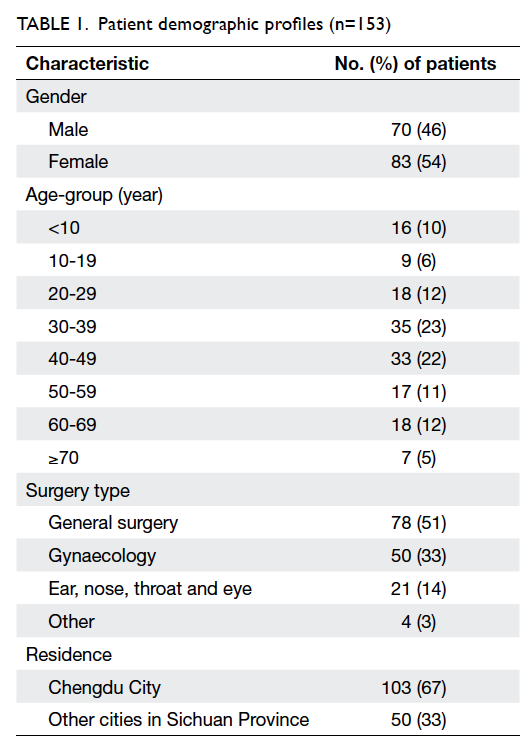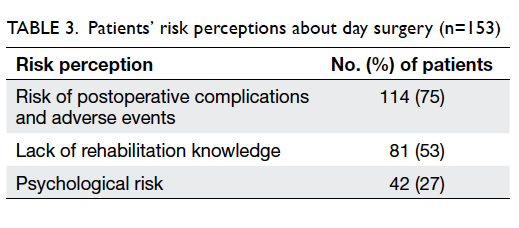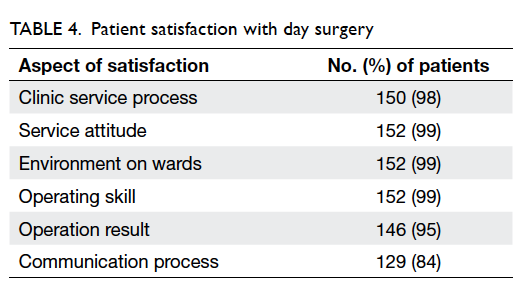Hong Kong Med J 2014;20:134–8 | Number 2, April 2014 | Epub 7 Oct 2013
DOI: 10.12809/hkmj133966
© Hong Kong Academy of Medicine. CC BY-NC-ND 4.0
ORIGINAL ARTICLE
Patients’ perceptions of day surgery: a survey
study in China surgery
WP Yu, PhD1;
Y Chen, MB, BS2;
GM Duan, PhD1;
H Hu, PhD2;
HS Ma, MB, BS3;
Y Dai, MB, BS3
1 Business School of
Sichuan University, Chengdu, China
2 State Key Laboratory of
Quality Research in Chinese Medicine, Institute of Chinese Medical
Sciences, University of Macau, Taipa, Macao
3 West China Hospital,
Sichuan University, Chengdu, China
Corresponding author: Dr H Hu (haohu@umac.mo)
Abstract
Objective: To
investigate patients’ perceptions of
day surgery, specifically their convenience; social,
functional and economic values; risk perceptions;
and patient satisfaction.
Design: Cross-sectional
questionnaire survey.
Setting: West China
Hospital in Chengdu City,
China.
Participants: All the
day-surgery patients admitted
to the Centre for Day Surgery in December 2011.
Main outcome measures: Demographic
profiles,
each patient’s value and risk perceptions about
day surgery, as well as overall satisfaction with day
surgery.
Results: Convenience
value and social value
were emphasised by 87% and 60% of the 153 valid
respondents, respectively. Comparatively speaking,
functional and economic value were respectively
chosen by 50% and 43% of the respondents, while
75% worried about postoperative complications and
adverse events, only 53% and 27% worried about
rehabilitation knowledge and psychological risks,
respectively. More than 95% of the respondents were
satisfied with the clinic service and staff attitudes,
hospital surgery environment, operating skills and results, but
fewer (84%) were satisfied with the
communication processes surrounding day surgery.
Conclusion: Patients
exhibited high acceptance and
satisfaction regarding day surgery. The convenience
experienced by patients and their families is the main
perceived value of day surgery. Nevertheless, during
the recovery process patients are concerned about
possible adverse events, treatment of postoperative
complications, and lack of information. These
aspects of care delivery warrant improvement
through redesign of the day surgery service.
New knowledge added by this
study
- Patients appreciate the convenience and social benefits of day surgery, but are worried about postoperative complications and adverse events.
- Educations about day surgery should be provided to both health care workers and the public to enhance understanding of day surgery services.
- Hospitals should communicate with patients better during and after day surgery.
- Specific mechanisms for dealing with postoperative complications and adverse events after day surgery should be established.
Introduction
Day surgery is defined as a process in
which a patient
undergoes surgery and stays in the hospital for less
than 24 hours.1 As an innovative form of medical
practice, it is growing increasingly popular globally.2 3 4
For example, around 70% to 80% of North American
patients expressed a preference for day surgery.5
In Scotland, among all operations the percentage
involving day surgery increased 570% from 1981 to
1995.6 Advances in surgical technology continue to
render day surgery more acceptable and suitable for
minimally invasive or minor operations compared with traditional
surgery, thus expanding its scope.
In the past, almost all surgical patients had to stay
in hospital until they were capable of caring for
themselves and became ambulant, and they returned
to hospital for removal of sutures. Under such
circumstances, even for wound healing, patients
had to stay in hospital for 21 days, which generated
great social and economic pressure that patients and
their families had to endure. Comparatively, many
patients find day surgery to be more ‘economical and
reliable’.7 Day surgery can provide not only economic,
but also social advantages to patients. These include shorter
hospital stays, avoiding the drawbacks of
a hospital environment (cross-infection and less
inconvenience to family members).8 Day surgery
also benefits hospitals by increasing the quantity of
successful operations, while maintaining efficient
use of resources.
Many patients nevertheless worry about
the uncertainties of day surgery. In addition to
the uncertainty inherent in the operation itself,
the more rapid day surgery model creates unique
challenges for postoperative care. Many patients
worry about the uncertainty of their postoperative
recoveries.9 Some choose continuous rest in hospital
post-surgery, thinking it better to recover under
the direct supervision of doctors, which tend to
counter day surgery preferences.10 For patients,
these uncertainties make day surgery a controversial
medical choice, despite its many advantages.11
Consequently, further exploration of
patient
perceptions about day surgery becomes crucial
to accomplish long-term improvements and the
promotion of such practice, which is particularly
important where day surgery is in its infancy, such
as in China. There was no day surgery in China until
2005, when hospitals in Chengdu, Shanghai, Tianjin,
and elsewhere began to experiment with the concept
to address the rising demand for surgery. Hospitals
and doctors therefore have strong motivation to
appreciate patients’ perceptions of day surgery,
wherever it is a fairly new medical service.
Therefore, the aim of this study was to
investigate patients’ perceptions of day surgery—specifically with regard to convenience; social,
functional and economic attributes; risk perceptions;
and overall satisfaction.
Methods
Study design and sampling
The study was conducted using a
questionnaire
survey in the West China Hospital, Sichuan
Province, China. This hospital was founded in 1892,
and is one of the country’s leading general hospitals.
It is affiliated to Sichuan University, which has been
selected as a national clinical and education base by
the Ministry of Health, China. It has 7800 employees
and 38 clinical departments providing complete
medical services covering all clinical areas. Being
the most highly regarded hospital in southwestern
China, it copes with an ever-increasing demand for
surgery, for which reason the Centre for Day Surgery
was created.
This survey study was reviewed and approved
by West China Hospital in advance, and involved
interviews of all 225 patients admitted to the Centre
in December 2011. In all, questionnaires were
directly distributed to 200 patients post-surgery
and collected on-site after completion by the adult patients
themselves or the family members
of patients younger than 16 years old. In addition,
telephone survey was conducted for another 25
patients who had left hospital at once after the
surgery. The telephone survey questionnaires were
conducted verbally and completed by the researcher.
Informed consent was obtained from all patients
and/or carers before the questionnaire was used.
Measurement
The questionnaire comprised four parts. The first
collected background information including the
patient’s gender, age, residence location, and surgery
type. The second explored each patient’s perceptions
about day surgery, including: (1) convenience (defined
as shorter in-patient and treatment duration); (2)
social value, in terms of reducing its impact on
the lives of family members; (3) functional value
(receipt of safer and more effective treatment); and
(4) economic value, defined as saving in expenses by
patient and carers (from loss of earnings and travel
by patient and carers). The third part evaluated the
patient’s perceptions of day surgery, in terms of:
(1) risk of postoperative complications and adverse
events, not amenable to timely treatment after
returning home; (2) uncertainty about the risks of the
rehabilitation process (defined as insufficient medical
knowledge about rehabilitation in the absence of
medical care); and (3) psychological risk, described
in terms of insufficient psychological preparation
for recovery in the absence of medical care. The fourth part explored the patient’s satisfaction with
day surgery, including the clinical service, attitude
of staff, hospital surgery environment, operating
skills, operation results, and communication with
the patient. In the last three parts, the patients were
asked to choose “Yes” or “No” answers.
Data analysis
We used the Statistical Package for the Social
Sciences (Windows version 19.0; SPSS Inc,
Chicago [IL], US) for the statistical analysis. All the
continuous variables were presented as means and
standard deviations (SDs). Categorical variables were
presented as frequencies and percentages. Fisher’s
exact test was applied to compare the different value
perceptions according to surgery types. A two-tailed P value of <0.05 was considered statistically
significant.
Results
General sample information
From the 225 questionnaires, those with
incomplete answers were removed. Finally 153 valid
questionnaires were obtained, giving a completion
rate of 68%. The background information about
these 153 patients (70 males and 83 females) is
summarised in Table 1. The mean age of the patients
was 39 (SD, 20) years. In all, 67% of the patients
came from Chengdu City and the others were from
other cities in Sichuan Province. More than half
of the patients underwent general surgery; 63% of
them already knew about day surgery to some extent
before hospitalisation for their surgery.
Perceptions about the value of day surgery
As shown in Table 2, the convenience value related
to shorter in-patient stays and treatment duration
was the most emphasised (87%). The social value
of reducing the influence of surgery on the lives of
the patients and their family members was chosen
by 60% of the respondents. Comparatively, the
functional value for patients receiving safer and
more effective treatment and the greater economic
value (reducing expenditure on surgery) was chosen
by 50% and 43% of the respondents, respectively.
Table 2 also shows the numbers of patients
having “Yes” or “No” responses for each type of
surgery and for different perception categories. It
illustrates that respondents undergoing different
types of day surgery had significantly varied
perceptions about its convenience, but there were no
significant differences in terms of social, functional,
or economic perceptions.
Risk perceptions of day surgery
Regarding patient perceptions about the risks of day
surgery, most (75%) worried that they would not
receive timely treatment if they were to experience a
sudden postoperative complication or adverse event after discharge. About half of the respondents were
concerned about rehabilitation knowledge that was
inherent in the absence of medical professionals
to provide specific advice during recovery. This
shortfall of medical knowledge could inhibit and
lengthen the recovery period. In contrast, only 27%
of the respondents considered there was significant
psychological risk from day surgery (Table 3). There
was no significant difference among the different
surgery types with respect to risk perceptions.
Patient satisfaction with day surgery
Table 4 reveals that the respondents were
generally satisfied with day surgery. More than
95% were satisfied with the clinic service process,
service attitude of the staff, the hospital surgery
environment, operating skills and the results. Fewer
respondents (84%) expressed satisfaction with the
communication processes surrounding day surgery,
but there was no significant difference for this
parameter for the different surgery types.
Discussion
Our study indicates that day surgery (a new type of
medical service in China) is being applied to patients
of various ages, as shown by the wide distribution of
patient age-groups. Minimally invasive operations,
particularly general and gynaecological surgeries,
were the main types. Day surgery was embraced not
only by patients from that city but also those from
other cities. This implies patients’ appreciation for
efficiency of day surgery.
The efficiency that day surgery delivered to
patients was considerable convenience, which was
highly valued. Patients think day surgery can save them from having to spend time in hospital, and
decrease interruptions to their normal lives. Patients
who underwent ear, nose and throat surgery,
eye surgery, and gynaecological surgery placed
significant emphasis on the convenience of day
surgery. Moreover, the social value was emphasised,
in that day surgery required less additional care by
family members. Patients paid much less attention
to functional and economic aspects, which suggests
that while patients were confident about the quality
of day surgery, its monetary burden was not a major
determinant for them. Convenience for patients and
their families was the main reason they choose day
surgery, which implies that hospital should promote
and emphasise this aspect.
Although our study acknowledges the value of
day surgery, it nevertheless reveals that patients are
conscious of and concerned about its potential risks.
Risk of postoperative complications and adverse
events posed a particular concern, more so than lack
of rehabilitation knowledge and any psychological
risks. Because patients must be discharged soon after
surgery, they worry about unexpected postoperative
complications or adverse events, where they might
not be able to receive timely appropriate treatment,
unlike the situation for in-patient recovery. In
addition, the patients were concerned about whether
they would experience smooth rehabilitation at
home, without recourse to professional medical
and psychological consultation opportunities with
doctors or nurses.
Patient satisfaction is an important indicator
for assessing improvements in medical service.12
The patients in this study generally exhibited high
degree of satisfaction with day surgery, which is
consistent with findings in the literature.13 While
most were satisfied with the clinical service process,
service attitude, the hospital surgery environment,
and operating skills and results, some expressed
dissatisfaction with the levels of communication.
They complained that hospital staff lacked requisite
communication skills to put patients and their
family members at ease, resulting in pre- and post-surgery
anxiety. Despite time constraints, in the
context of day surgery, sufficient communication
and interaction between patients and hospital staff is
very important.
Both patients and health care workers very
likely have concerns and uncertainties regarding the
change from usual in-patient surgery to day surgery.
Therefore, it is important to provide education
to health care workers as well as the public to
enhance their understanding of day surgery as a
new medical service. Specifically, hospitals should
enhance communications between doctors and
day surgery patients, pre- and post-surgery, to
increase understanding of what it involves, so as to
decrease their concerns about risks and facilitate recovery. Specific training and reference materials
about possible post-surgery complications and
other problems could be provided to patients and
their family members. Hospitals can also establish
telephone consulting services to patients who have
undergone day surgery to deal with enquiries about
the recovery process. Moreover, specific mechanisms
should be established to address possible recovery
accidents, providing patients with rapid access to in-patient
medical treatment rather than ordinary out-patient
services.
Regarding the limitations of this study, it
focused only on patients who had undergone day
surgery in December 2011, which may only reflect information
about day surgery during its development
stages. Nevertheless, patients’ perceptions of day surgery
remain a potential topic for further investigation.
Additional research in more hospitals could provide
a more comprehensive understanding of day surgery
as a new medical practice. We studied day surgery
patients from West China Hospital, but given that
day surgery practice may be significantly diversified,
replication of this study elsewhere could provide
more diverse insights. Second, future study could
investigate doctors’ perceptions of day surgery.
As key operators of the day surgery model, they
are crucial to its success and their opinions and
suggestions have not been systematically addressed
in the literature. Future studies could target this gap
to enrich the understanding of day surgery from
both sides (doctors and patients). Third, comparative
studies addressing patients who refuse day surgery
are also necessary. These types of initiatives could
provide more useful information about how to
improve the practice of day surgery so as to increase
patient acceptance and outcomes.
Conclusion
This study showed that the majority of patients
studied accepted day surgery as an innovative
medical service that offers significant convenience
and social value. Main patient concerns were
postoperative complications and adverse events and
the lack of adequate communication with doctors
and nurses about their surgery and recovery process.
More convenient and comprehensive design of day surgery programmes may help to promote day
surgery for more patients.
Acknowledgements
This research is supported by the key special project
of Central University basic scientific research
expenses (Philosophy and Social Sciences) of Sichuan
University (No.skqy201208) “Hospital outpatient
service quality evaluation and optimization strategy
based on the patients’ satisfaction” and the key project
of NSFC “Resource dispatching and optimizing
research in medical service (No.71131006)”.
References
1. Otte DI. Patients' perspectives and experiences of day case surgery. J Adv Nurs 1996;23:1228-37. CrossRef
2. Sanares-Ousley D, Bernier M, Newhouse P. Actual versus valued preoperative teaching before day surgery: patient's perspective. AORN J 1999;69:1133-4.
3. Markovic M, Bandyopadhyay M, Manderson L, et al. Day surgery in Australia: qualitative research report. J Sociol 2004;40:74-84. CrossRef
4. Ojo EO. Day case surgery and developing countries: a review. Niger J Clin Pract 2010;13:459-66.
5. Jenkins K, Grady D, Wong J, Correa R, Armanious S, Chung F. Post-operative recovery: day surgery patients' preferences. Br J Anaesth 2001;86:272-4. CrossRef
6. Bain J, Kelly H, Snadden D, Staines H. Day surgery in Scotland: patient satisfaction and outcomes. Qual Health Care 1999;8:86-91. CrossRef
7. Davies AR, Ware JE Jr. Involving consumers in quality of care assessment. Health Aff (Millwood) 1988;7:33-48. CrossRef
8. Bittmann S, Ulus H. Parent satisfaction with paediatric day-surgery: a questionnaire-based study. Ambul Surg 2004;11:3-5. CrossRef
9. Ojo EO, Ihezue CH, Sule AZ, Ramyil VM, Misauno MA. The scope and utilisation of day case surgery in a developing country. East Afr Med J 2007;84:200-6.
10. Lee YC, Chen PP, Yap J, Yeo P, Chu C. Attitudes towards day-case surgery in Hong Kong Chinese patients. Hong Kong Med J 2007;13:298-303.
11. Alexander-Williams J. Arguments for day case surgery. Practitioner 1996;240:152-60.
12. Attree M. Patients' and relatives' experiences and perspectives of 'Good' and 'Not so Good' quality care. J Adv Nurs 2001;33:456-66. CrossRef
13. Lemos P, Pinto A, Morais G, et al. Patient satisfaction following day surgery. J Clin Anesth 2009;21:200-5. CrossRef





